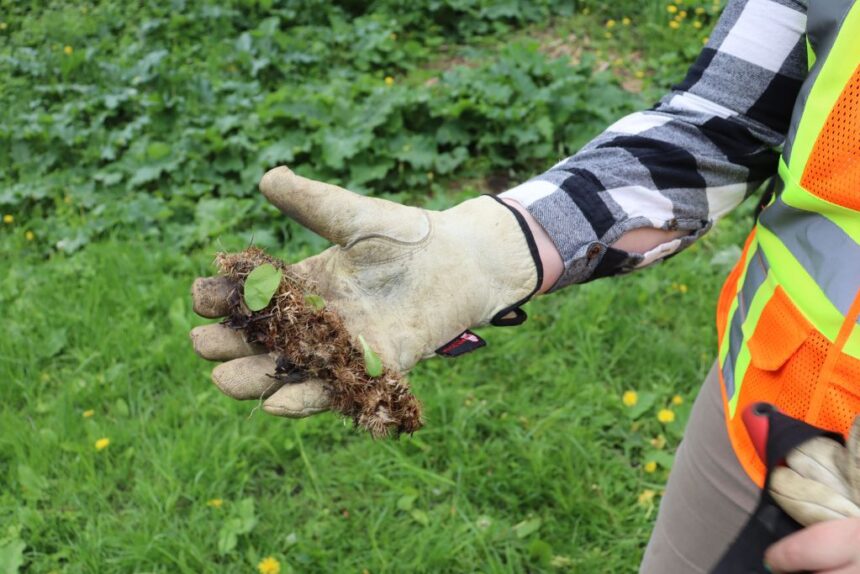START – Apple News Only Block Add content to the Apple News only block. You can add things like headings, paragraphs, images, galleries and audio clips. The content added here will not be visable on the website article Get the inside scoop on The Narwhal’s environment and climate reporting by signing up for our free newsletter. END – Apple News Only Block Once you know what burdock and garlic mustard look like, you won’t stop spotting them in Toronto’s parks, according to the volunteers working to remove invasive plant species at Trinity Bellwoods Park. That’s exactly what happened with Shân Gordon, a local from the area who started the park’s invasive species removal campaign. She was practicing walking meditation in Trinity Bellwoods last year and couldn’t ignore the extent of the park’s burdock and garlic mustard takeover. Gordon approached Friends of Trinity Bellwoods, a volunteer organization working to improve and maintain the park, and learned there was no coordinated effort to remove invasive plants. So, she joined the organization to lead the charge. Volunteers work to remove invasive burdock from around the Trinity Bellwoods Park dog bowl. While invasive burdock is edible, you probably wouldn’t want to forage it — or anything else — from a dog park. With the blessing of the city’s Trinity Bellwoods park supervisor, Gordon and other volunteers have since been hard at work removing burdock and garlic mustard — two common invasive plant species in Ontario. Trinity Bellwoods may be mostly manicured lawn, but the area around the dog bowl — a manmade pit turned off-leash dog park — runs wild. There, burdock and garlic mustard abound. Both plant species are edible and are popular fare among urban foragers. Toronto park bylaws prohibit foraging in city parks, but you wouldn’t want to eat the burdock or garlic mustard at Trinity Bellwoods anyway, Gordon said, due to the risk of dog waste contaminating the plants. During a Saturday morning stewardship event in late May, Gordon and volunteer Jo Moore demonstrated how to remove these invasive plants. For garlic mustard, volunteers simply pull it out of the ground and discard it in a bucket. But removing burdock is a much more involved process. Moore used a hand hoe to dig into the soil and reveal the plant’s thick roots. She then cut through the stalk with garden shears and discarded the plant on the ground to allow sunlight to kill it. Burdock is a large leafy plant that looks similar to rhubarb. Its seed heads can cause injuries to wildlife and dogs, and also entrap birds and block sunlight from reaching native plants. At this point in the spring, the burdock plants don’t yet have seeds, Gordon explained, which means volunteers can leave the uprooted plants on the ground to enrich the soil. If the burdock had seeds, volunteers would place the plants in a garbage bag before leaving it out in the sun. In the summer, burdock generates seed heads, or burrs, which pose a risk to wildlife and the many dogs in the area. The burrs easily cling to dog fur and can cause skin irritation, paw problems and an oral condition called burr tongue. Dog owners often express their gratitude to the Trinity Bellwoods volunteers while they remove burdock, according to Ada Diemer, who has volunteered alongside Gordon for the past year. “It’s not a thankless job,” she laughed. For songbirds and native plants, though, burdock poses a life-threatening danger. It crowds out native plants by blocking sunlight with its large leaves. Meanwhile, songbirds can become entangled in its burrs and die. As for garlic mustard, the invasive species is known to take over forest understories by emitting chemicals into the soil that inhibit the growth of other plants. Eradicating invasive species isn’t a one and done deal. Consistent management over years is needed, Gordon said. Gordon and Diemer said they’ve noticed a difference since volunteers started removing the invasive plants last year, but there’s still a long way to go. Gordon estimated it would take between five and 10 years of consistent effort to completely eliminate the invasive plants from the park. “And then continued maintenance,” she said. Shân Gordon points out garlic mustard, identifiable by its tiny white flowers and long, thin stem. Removing invasive plants like garlic mustard is not a “one and done” project, but an ongoing endeavour to protect native species. The area that volunteers cleared on that May Saturday morning, south of the dog bowl, had already been cleared the year before and will likely need clearing again. Burdock “has such a strong, deep root that you need to just keep chipping away at it,” Diemer explained. “We’ll try to get as much of the root as we can and then it will probably still come back.” With each removal, the burdock gets weaker and weaker, allowing native plants like the flowering goldenrod to re-establish itself. The problem isn’t localized to Trinity Bellwoods, the volunteers said. Every Toronto park is inundated. “It’s shocking how widespread it is,” Diemer said. “I would be surprised if there is any park… that doesn’t have at least one invasive species in it.” The spread of invasive species is considered one of the greatest threats to biodiversity, second only to habitat loss, according to the Toronto and Region Conservation Authority . Combined, municipalities and conservation authorities across Ontario spend about $51 million annually to manage invasive species. To reduce the spread of invasive species, the conservation authority recommends planting native wildflowers, trees and shrubs and cleaning yourself and your gear before moving to different areas. Recent Posts Alberta moves to weaken its carbon price amidst talk of national ‘grand bargain’ Document shows proposals from the Alberta government could enable thousands of oil and gas facilities… Packing a lack of shame this summer How do we build stronger connections to nature? This week, we look at efforts across…
Invasive plant removal will take years in this downtown Toronto park












